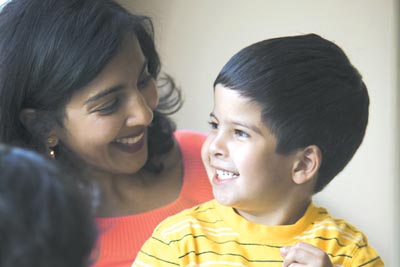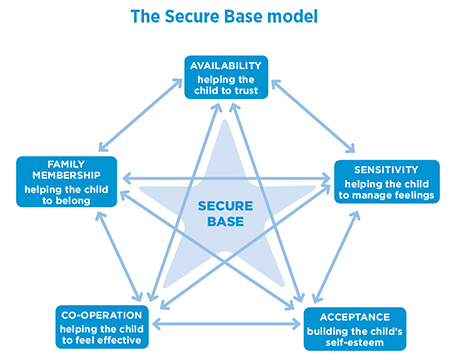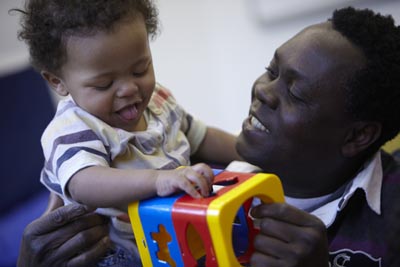Introduction to the Secure Base Model
The Secure Base model provides a positive framework for therapeutic caregiving which helps infants, children and young people to move towards greater security and builds resilience. The model focuses on the interactions that occur between caregivers and children on a day to day, minute by minute basis within the caregiving environment. But it also considers how those relationships can enable the child to develop competence in the outside world of school, peer group and community.

It can be helpful, first, to think about caregiver/child interactions as having the potential to shape the thinking and feeling and ultimately the behaviour of the child.
This process begins with the child's needs and behaviour and then focuses on what is going on in the mind of the caregiver. How a caregiver thinks and feels about a child's needs and behaviour will determine his or her caregiving behaviours. The caregiver may draw on their own ideas about what children need or what makes a good parent from their own experiences or from what they have learned from training.
The caregiving behaviours that result convey certain messages to the child. The child's thinking and feeling about themselves and other people will be affected by these messages and there will be a consequent impact on his or her development. We have chosen to represent this process in a circular model, the caregiving cycle, which shows the inter-connectedness of caregiver/child minds and behaviour, as well as their ongoing movement and change.

This caregiving cycle encompasses the many interactions of family life or life in a residential care setting. These range from the moment to moment exchanges over breakfast to managing major emotional or behavioural crises. Each interaction conveys a number of messages to the child and has an incremental effect on the child's beliefs about him or herself, beliefs about other people and the relationship between self and others. These internal working models will influence the child's functioning and development.
For the purposes of the Secure Base model, we have grouped these caregiver/child interactions into five dimensions of caregiving. The first four dimensions are drawn from attachment theory. We have added to the model an additional dimension, family membership, that is relevant for all children but can be particularly challenging for children who are separated from their families of origin.
Each of the five caregiving dimensions can be associated with a particular developmental benefit for the child, as shown in the table below and positive caregiving guidance for each dimension is outlined in this guide to Positive caregiving approaches.
Availability | Helping the child to trust | |||
|---|---|---|---|---|
Sensitivity | Helping the child to manage feelings and behaviour | |||
Acceptance | Building the child's self esteem | |||
Co-operation | Helping the child to feel effective | |||
Family membership | Helping the child to belong |
The caregiving dimensions and their developmental benefit to the child are represented by the The Secure Base model, with the caregiving cycle used to explain each dimension.
It is important to bear in mind that the dimensions are not entirely distinct from each other. Rather, in the real world of caregiving, they overlap and combine with each other. For example, a caregiver who is playing with a child in a focused, child-led way may be doing so with sensitivity and acceptance as well as demonstrating availability and promoting co-operation.
Research (Beek and Schofield 2004) has demonstrated that, over time, positive caregiving across the five dimensions provides a secure base from which the child can explore, learn and develop in a positive direction.

Implications for practice
The Secure Base Model provides a framework for caregivers and for those who support them to think in more detail about the different but connected caregiving approaches that can help a child to move towards greater security. It is a positive, strengths based approach that focuses on the interaction between the caregiver and the child, but also considers how that relationship can enable the child to develop competence in the outside world and manage often complex relationships with birth family members.


)